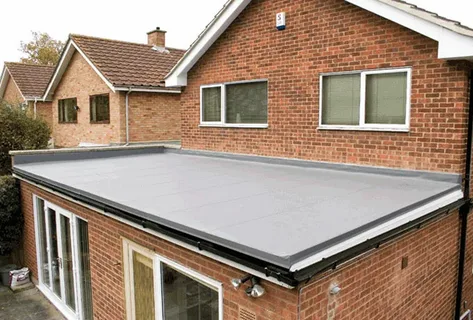Flat roof systems are becoming increasingly popular when it comes to roofing options. They provide a unique set of advantages and challenges that are worth exploring. In this blog post, we'll dive deep into flat roof systems, discussing their benefits, characteristics, drawbacks, and considerations for installation and maintenance.
Introduction:
Flat roof systems have been used for centuries in different forms, from ancient civilizations to modern architecture. Their appeal lies in their minimalist and sleek design, making them a common choice for commercial and residential properties. However, like any roofing system, they come with their considerations.
Characteristics of Flat Roof Systems:
Flat roof systems, often called low-slope roofs, differ significantly from the pitched or sloped roofs over and over found on houses. Here are some key characteristics of flat roof systems:
- Minimal Slope: Flat roofs have a low pitch, typically ranging from 1/2 inch to 2 inches per foot. This design allows for efficient use of space and creates a modern and clean aesthetic.
- Materials: Different materials are used in flat roof construction, including built-up roofing (BUR), single-ply membrane, modified bitumen, and more. The option of material relies on factors such as climate, budget, and intended use.
- Accessibility: Flat roofs often offer accessibility for maintenance and installation of equipment like solar panels, HVAC units, and green roofs. This accessibility is an important advantage for commercial properties.
Advantages of Flat Roof Systems:
Flat roof systems offer many advantages that make them a preferred choice for various property owners:
- Cost-Effective: Flat roofs are mostly less expensive to install and maintain than pitched roofs, making them an economical choice for residential and commercial properties.
- Space Utilization: The flat surface allows for efficient use of the roof space. It can be transformed into a functional area for gardens, lounges, or even additional living space.
- Easy Maintenance: Routine maintenance tasks like inspections and cleaning are more accessible and straightforward on flat roofs. It can help increase the lifespan of the roofing system.
- Energy Efficiency: Flat roofs can accommodate energy-efficient technologies like green roofs and solar panels, minimizing energy costs and contributing to sustainability.
- Modern Aesthetic: Flat roofs' sleek and minimalist design adds a modern touch to buildings, increasing their overall curb appeal.
Challenges of Flat Roof Systems:
While flat roof systems have their advantages, they also come with some challenges:
- Drainage Issues: Flat roofs are susceptible to water pooling, which can lead to leaks and structural damage if not managed properly. Adequate drainage systems are essential.
- Weather Sensitivity: Flat roofs are more sensitive to weather conditions, especially in areas with heavy rainfall or snowfall. Proper insulation and waterproofing are crucial to prevent water infiltration.
- Maintenance Requirements: Although maintenance is easier on flat roofs, it is essential. Neglecting maintenance can lead to significant issues and costly repairs.
- Limited Insulation Options: Insulating a flat roof can be more challenging than a pitched roof, but it's crucial for energy efficiency and climate control.
- Potential for Leaks: Flat roofs have seams and junctions that can be vulnerable to leaks. Regular inspections are necessary to detect and address these issues promptly.
Considerations for Installation and Maintenance:
If you're considering a flat roof system for your property, there are a few important options :
- Consult a Professional: Always consult with a roofing professional with flat roof experience. They can assist you in choosing the right design and material for your specific needs.
- Proper Drainage: Ensure your flat roof has an effective drainage system to prevent water pooling and potential damage.
- Regular Inspections: Schedule regular inspections and maintenance to point out and address issues before they become costly problems.
- Quality Materials: Invest in high-quality roofing materials and a professional installation to ensure longevity and performance.
- Energy Efficiency: Consider energy-efficient options such as cool roofing materials, insulation, and the possibility of solar panels or a green roof.
Conclusion:
Flat roof systems offer a contemporary and cost-effective roofing solution with various benefits for both residential and commercial properties. However, they also present unique challenges that require careful consideration, proper installation, and maintenance. Property owners can make informed decisions when choosing a flat roof system by understanding these advantages and challenges.
If you're looking for a roofing solution that combines aesthetics, functionality, and cost-effectiveness, flat roof systems might be the right choice. Remember to consult with a roofing expert to determine the best flat roofing options for your specific needs.


No comments yet